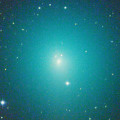
|
Now it is very bright as 6.9 mag (Apr. 21, Juan Jose Gonzalez). It approached to Earth down to 0.14 a.u. from late March to early April. It is still very close to the Earth, around 0.2 a.u. It is observable in excellent condition in the Northern Hemisphere. It becomes observable again after late April also in the Southern Hemisphere.
Date(TT) R.A. (2000) Decl. Delta r Elong. m1 Best Time(A, h)
Apr. 22 17 42.02 48 56.6 0.170 1.053 101 5.8 3:41 (180, 76)
Apr. 29 18 7.39 41 31.9 0.187 1.068 104 6.2 3:38 (181, 83)
|
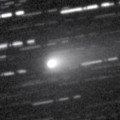
|
Outburst occured on Apr. 4, and it brightened by 2 mag, up to 6.2 mag (Apr. 7, Juan Jose Gonzalez). It is very bright as 7.0 mag still now (Apr. 21, Juan Jose Gonzalez). It stays observable for a long time after this. But it locates low in the Northern Hemisphere.
Date(TT) R.A. (2000) Decl. Delta r Elong. m1 Best Time(A, h)
Apr. 22 22 13.86 -6 31.6 1.180 1.085 58 7.2 3:49 (290, 15)
Apr. 29 22 46.65 -2 51.0 1.193 1.058 56 7.1 3:38 (284, 15)
|
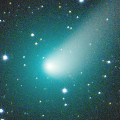
|
Now it is 9.2 mag (Apr. 21, Juan Jose Gonzalez). It was expected to brighten up to 6-7 mag from April to July. But it is fainter than predicted recently. In the Northern Hemisphere, it stays observable in excellent condition until June. In the Southern Hemisphere, it stays extremely low for a while.
Date(TT) R.A. (2000) Decl. Delta r Elong. m1 Best Time(A, h)
Apr. 22 16 10.71 46 10.5 1.103 1.775 114 7.7 2:11 (180, 79)
Apr. 29 15 57.84 44 33.4 1.031 1.741 117 7.5 1:31 (180, 80)
|
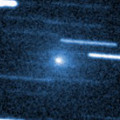
|
Now it is 10.9 mag (Apr. 5, Chris Wyatt). It stays 10-11 mag until May. It is not observable now in the Northern Hemisphere. In the Southern Hemisphere, it stays observable for a long time, but it stays low. Juan Jose Gonzalez reported it is very bright as 7.9 mag on Apr. 7.
Date(TT) R.A. (2000) Decl. Delta r Elong. m1 Best Time(A, h)
Apr. 22 23 39.71 -0 46.0 1.508 0.926 36 10.9 3:49 (272, 2)
Apr. 29 0 9.89 0 45.3 1.572 0.963 36 11.2 3:38 (269, 0)
|

|
It has not been observed yet in this apparition. The condition of this apparition is worst. It will brighten up to 10 mag in spring, but not observable at all.
Date(TT) R.A. (2000) Decl. Delta r Elong. m1 Best Time(A, h)
Apr. 22 2 20.71 13 38.1 2.062 1.066 5 11.1 20:08 (117,-13)
Apr. 29 2 50.95 14 58.9 2.068 1.072 6 10.9 20:16 (119,-13)
|
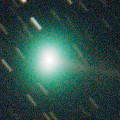
|
It brightened very rapidly, and brightened up to 6.3 mag (Apr. 2, Terry Lovejoy). However, the nucleus was disintegrated, and it is fading and getting diffuse rapidly after Apr. 9. It has already faded down to 10.5 mag (Apr. 19, Ken-ichi Kadota). In the Southern Hemisphere, it is already unobservable. It will be unobservable soon also in the Northern Hemisphere.
Date(TT) R.A. (2000) Decl. Delta r Elong. m1 Best Time(A, h)
Apr. 22 1 5.10 36 53.3 1.061 0.495 27 11.0 3:49 (230, 8)
Apr. 29 1 50.40 35 15.6 1.274 0.513 22 12.5 3:38 (227, 2)
|
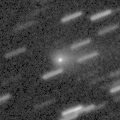
|
Now it is 12.7 mag (Apr. 20, Thomas Lehmann). It is expected to brighten up to 10 mag in summer. It will be observable in excellent condition in the Southern Hemisphere. It locates low in the Northern Hemisphere.
Date(TT) R.A. (2000) Decl. Delta r Elong. m1 Best Time(A, h)
Apr. 22 16 37.17 -18 22.2 0.812 1.716 141 12.0 2:38 ( 0, 37)
Apr. 29 16 40.37 -19 35.6 0.755 1.693 147 11.7 2:13 ( 0, 35)
|
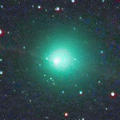
|
Now it is fading rapidly. It has already faded down to 10.9 mag (Apr. 14, Thomas Lehmann). In the Southern Hemisphere, it stays observable after this while the comet will be fading. In the Northern Hemisphere, it stays unobservable until May when it becomes fainter than 14 mag.
Date(TT) R.A. (2000) Decl. Delta r Elong. m1 Best Time(A, h)
Apr. 22 22 43.52 -17 38.7 1.116 1.011 56 12.6 3:49 (294, 3)
Apr. 29 22 47.86 -17 20.7 1.153 1.123 62 13.4 3:38 (295, 5)
|
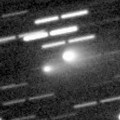
|
Now it is 12.3 mag (Apr. 5, Chris Wyatt). Bright new fragment BT was discovered on Feb. 10. Now the fragment BT is fainter than the primary component. In the Southern Hemisphere, it stays observable for a long time after this. In the Northern Hemisphere, it is not observable temporarily until mid June.
Date(TT) R.A. (2000) Decl. Delta r Elong. m1 Best Time(A, h)
Apr. 22 23 36.43 -9 56.9 1.625 1.100 41 13.1 3:49 (280, -3)
Apr. 29 23 59.52 -7 59.0 1.667 1.147 42 13.4 3:38 (278, -3)
|

|
Now it is 15.7 mag (Apr. 1, Kunihiro Shima). It locates high in the Southern Hemisphere.
Date(TT) R.A. (2000) Decl. Delta r Elong. m1 Best Time(A, h)
Apr. 22 21 31.11 -14 56.7 6.090 5.850 71 13.7 3:49 (303, 17)
Apr. 29 21 34.10 -14 37.5 5.982 5.848 77 13.6 3:38 (306, 20)
|
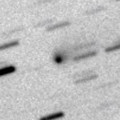
|
Now it is 15.8 mag (Apr. 2, Kunihiro Shima). It will brighten up to 14 mag from spring to summer. It locates somewhat low in the Northern Hemisphere. The perihelion distance increased from 2.4 a.u. to 2.9 a.u. in this apparition. So it will not be bright as before.
Date(TT) R.A. (2000) Decl. Delta r Elong. m1 Best Time(A, h)
Apr. 22 16 28.95 -20 43.1 2.177 3.041 143 14.3 2:30 ( 0, 34)
Apr. 29 16 26.06 -20 54.8 2.114 3.031 150 14.2 1:59 ( 0, 34)
|
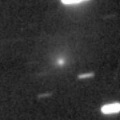
|
Now it is bright as 14.4 mag (Jan. 14, Thomas Lehmann). It is not observable now in the Northern Hemisphere. It will be unobservable temporarily in May also in the Southern Hemisphere. It will be getting higher gradually in the morning sky after summer. Then it will be observable at 11 mag for a long time from 2017 autumn to 2018 winter.
Date(TT) R.A. (2000) Decl. Delta r Elong. m1 Best Time(A, h)
Apr. 22 3 29.32 -15 52.4 5.393 4.616 35 14.3 20:08 ( 83,-17)
Apr. 29 3 35.22 -14 46.0 5.364 4.563 33 14.2 20:16 ( 88,-23)
|

|
It has not been observed yet in this apparition. It will brighten up to 12 mag in summer. It will be observable in excellent condition in the Southern Hemisphere. It locates somewhat low in the Northern Hemisphere.
Date(TT) R.A. (2000) Decl. Delta r Elong. m1 Best Time(A, h)
Apr. 22 19 3.82 -33 24.0 1.785 2.303 107 14.6 3:49 (343, 19)
Apr. 29 19 11.47 -33 23.0 1.686 2.278 113 14.4 3:38 (345, 20)
|
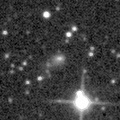
|
Now it is 15.9 mag (Mar. 30, Kunihiro Shima). It will be observable at 13 mag for a long time from 2017 to 2018.
Date(TT) R.A. (2000) Decl. Delta r Elong. m1 Best Time(A, h)
Apr. 22 19 2.42 9 47.8 4.267 4.574 101 14.6 3:49 (322, 60)
Apr. 29 18 57.74 11 19.6 4.131 4.540 107 14.5 3:38 (330, 64)
|
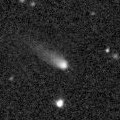
|
Now it is 15.6 mag (Feb. 15, Alexander Baransky). It will brighten up to 12-13 mag and will be observable in good condition in summer. Now it is not observable. It will appear in the morning sky in May.
Date(TT) R.A. (2000) Decl. Delta r Elong. m1 Best Time(A, h)
Apr. 22 0 20.70 14 18.2 3.919 3.028 23 14.7 3:49 (254, 2)
Apr. 29 0 21.67 14 33.4 3.829 2.997 29 14.6 3:38 (256, 5)
|
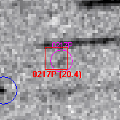
|
It will brighten rapidly, and it is expected to brighten up to 12 mag from July to September. In the Southern Hemisphere, it stays at the same altitude in the morning sky. In the Northern Hemisphere, it will be getting higher slowly.
Date(TT) R.A. (2000) Decl. Delta r Elong. m1 Best Time(A, h)
Apr. 22 22 35.43 -9 8.3 1.982 1.625 54 15.3 3:49 (288, 9)
Apr. 29 22 57.23 -7 43.3 1.895 1.573 56 15.0 3:38 (286, 9)
|
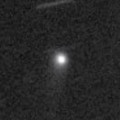
|
Appearing in the morning sky. In the Northern Hemisphere, it will brighten up to 14 mag from summer to next winter, and it will be observable in excellent condition. In the Southern Hemisphere, it will be observable in the very low sky only from May to June.
Date(TT) R.A. (2000) Decl. Delta r Elong. m1 Best Time(A, h)
Apr. 22 0 2.12 18 34.8 4.343 3.495 28 15.1 3:49 (253, 8)
Apr. 29 0 7.27 20 31.3 4.266 3.469 33 15.1 3:38 (253, 11)
|
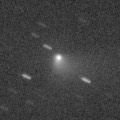
|
Small outburst occured in mid March. Now it is 14.6 mag (Mar. 26, Sandor Szabo). It is observable in excellent condition in the Northern Hemisphere. It stays low in the Southern Hemisphere.
Date(TT) R.A. (2000) Decl. Delta r Elong. m1 Best Time(A, h)
Apr. 22 11 29.73 29 0.8 1.933 2.645 125 15.2 21:27 ( 0, 84)
Apr. 29 11 29.69 27 48.5 2.015 2.667 120 15.4 21:00 ( 0, 83)
|

|
Now it is 15.6 mag (Mar. 6, Kunihiro Shima). Now it is not observable. But it will appear in the morning sky in June in the Southern Hemisphere, or in July in the Northern Hemisphere. Then it stays observable at 15.5 mag unil the end of 2017.
Date(TT) R.A. (2000) Decl. Delta r Elong. m1 Best Time(A, h)
Apr. 22 2 9.22 2 27.1 6.417 5.430 10 15.4 20:08 (111,-23)
Apr. 29 2 15.63 2 51.0 6.434 5.452 11 15.4 3:38 (248,-24)
|
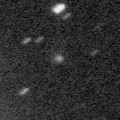
|
Now it is 16.6 mag (Apr. 15, Thomas Lehmann). It is expected to brighten up to 9 mag in summer in 2018. In the Northern Hemisphere, it stays observable until 2018 summer while the comet will be brightening. In the Southern Hemisphere, it is hardly observable in 2017, but it will be observable in good condition in 2018.
Date(TT) R.A. (2000) Decl. Delta r Elong. m1 Best Time(A, h)
Apr. 22 19 10.67 51 0.6 5.294 5.354 87 15.9 3:49 (216, 68)
Apr. 29 19 8.13 51 43.2 5.198 5.297 90 15.8 3:38 (209, 70)
|

|
Now it is 15.7 mag (Mar. 26, Sandor Szabo). It stays 16-17 mag for a long time from 2016 to 2019. It stays near by the equator.
Date(TT) R.A. (2000) Decl. Delta r Elong. m1 Best Time(A, h)
Apr. 22 9 5.62 6 8.4 9.281 9.589 104 16.0 20:08 ( 31, 57)
Apr. 29 9 6.47 6 21.4 9.388 9.586 98 16.0 20:16 ( 44, 53)
|

|
It brightened up to 11 mag from spring to summer in 2016. Now it is 16.8 mag (Apr. 2, Kunihiro Shima). It will be observable at 16-17 mag in good condition from spring to summer.
Date(TT) R.A. (2000) Decl. Delta r Elong. m1 Best Time(A, h)
Apr. 22 20 23.71 -17 27.3 2.723 2.866 87 16.1 3:49 (318, 26)
Apr. 29 20 27.85 -17 13.0 2.664 2.906 93 16.1 3:38 (321, 28)
|
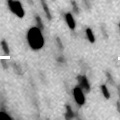
|
Now it is 17.3 mag (Mar. 3, T. Ikemura, H. Sato). It was observed at 16 mag from spring to summer in 2016. It will be observable at 16 mag also in 2017 from winter to spring.
Date(TT) R.A. (2000) Decl. Delta r Elong. m1 Best Time(A, h)
Apr. 22 18 27.44 11 56.3 3.003 3.465 109 16.2 3:49 (337, 65)
Apr. 29 18 27.85 14 1.4 2.964 3.491 113 16.2 3:38 (345, 68)
|

|
Now it is 16.6 mag (Mar. 30, Kunihiro Shima). It stays observable at 16 mag until June. It locates low in the Southern Hemisphere.
Date(TT) R.A. (2000) Decl. Delta r Elong. m1 Best Time(A, h)
Apr. 22 7 8.84 26 56.2 3.821 3.666 73 16.2 20:08 ( 91, 51)
Apr. 29 7 15.39 26 43.6 3.912 3.660 68 16.2 20:16 ( 95, 45)
|
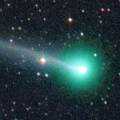
|
It approached to Earth down to 0.08 a.u. in mid February, and brightened up to 6.5 mag (Feb. 10, Danil Sidorko). Now it is fading rapidly. It has already faded down to 11.2 mag (Mar. 19, Osamu Miyazaki).
Date(TT) R.A. (2000) Decl. Delta r Elong. m1 Best Time(A, h)
Apr. 22 10 38.19 16 10.3 1.148 1.893 122 16.5 20:36 ( 0, 71)
Apr. 29 10 42.49 15 10.0 1.294 1.973 117 17.0 20:16 ( 2, 70)
|

|
It brightened up to 6.2 mag in June in 2016 (June 24, Marco Goiato). Now it is fading. But recently, it is bright as 15.6 mag (Apr. 2, Kunihiro Shima). In the Southern Hemisphee, it stays observable in excellent condition after this. It stays low in the Northern Hemisphere.
Date(TT) R.A. (2000) Decl. Delta r Elong. m1 Best Time(A, h)
Apr. 22 13 16.80 -30 44.1 3.719 4.672 159 16.5 23:13 ( 0, 24)
Apr. 29 13 6.91 -29 35.2 3.798 4.738 156 16.7 22:36 ( 0, 25)
|

|
Now it is 16.2 mag (Apr. 2, Kunihiro Shima). It stays 16.5 mag from 2016 to 2017. In the Northern Hemisphere, it stays observable in good condition for a long time. In the Southern Hemisphere, it will never be observable again.
Date(TT) R.A. (2000) Decl. Delta r Elong. m1 Best Time(A, h)
Apr. 22 19 3.68 55 6.8 6.269 6.310 87 16.6 3:49 (207, 66)
Apr. 29 19 3.98 56 33.4 6.259 6.317 88 16.6 3:38 (200, 66)
|

|
Now it is 17.3 mag (Mar. 6, iTelescope Observatory, Siding Spring). It will brighten up to 15.5 mag in summer. It will be observable in excellent condition in the Southern Hemisphere. In the Northern Hemisphere, it stays unobservable for some more time.
Date(TT) R.A. (2000) Decl. Delta r Elong. m1 Best Time(A, h)
Apr. 22 21 8.25 -44 1.6 2.510 2.643 86 16.7 3:49 (327, -1)
Apr. 29 21 19.95 -43 17.9 2.414 2.619 90 16.6 3:38 (327, 0)
|

|
It stayed bright 12 mag for a long time from autum in 2015 to summer in 2016. Now it is fading. It has already faded dwon to 16.2 mag (Apr. 1, Kunihiro Shima).
Date(TT) R.A. (2000) Decl. Delta r Elong. m1 Best Time(A, h)
Apr. 22 17 8.95 -9 39.0 4.066 4.811 133 16.6 3:10 ( 0, 45)
Apr. 29 17 3.63 -10 6.5 4.038 4.863 141 16.6 2:37 ( 0, 45)
|
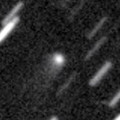
|
Now it is 16.2 mag (Mar. 26, Sandor Szabo). It stays 16 mag for a long time from 2017 to 2018.
Date(TT) R.A. (2000) Decl. Delta r Elong. m1 Best Time(A, h)
Apr. 22 8 16.50 7 41.8 5.424 5.563 92 16.6 20:08 ( 51, 52)
Apr. 29 8 15.78 8 38.9 5.533 5.548 85 16.7 20:16 ( 62, 47)
|

|
It has not been recovered yet in this apparition. It will brighten rapidly, and it is expected to be observable at 15.5 mag in good condition from July to September.
Date(TT) R.A. (2000) Decl. Delta r Elong. m1 Best Time(A, h)
Apr. 22 23 7.26 -23 54.9 3.031 2.593 55 16.9 3:49 (295, -6)
Apr. 29 23 19.63 -22 46.1 2.958 2.581 58 16.8 3:38 (295, -4)
|
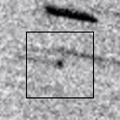
|
Although it was predicted to be fainter than 21 mag, an outburst occured and now it is very bright as 16.1 mag (Apr. 16, Hidetaka Sato). It stays observable in good condition for a while.
Date(TT) R.A. (2000) Decl. Delta r Elong. m1 Best Time(A, h)
Apr. 22 13 36.16 -21 25.3 2.191 3.184 169 16.9 23:33 ( 0, 34)
Apr. 29 13 29.91 -20 43.3 2.241 3.225 165 17.4 22:59 ( 0, 34)
|
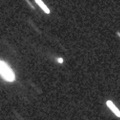
|
Now it is 16.2 mag (Mar. 30, Kunihiro Shima). It brightened rapidly, and became brighter than originally expected. It stays 16-17 mag until 2017. In the Northern Hemisphere, it stays observable in excellent condition for a long time. It is not observable in the Southern Hemisphere.
Date(TT) R.A. (2000) Decl. Delta r Elong. m1 Best Time(A, h)
Apr. 22 11 49.44 59 37.1 7.154 7.457 103 17.2 21:46 (180, 66)
Apr. 29 11 42.09 58 51.3 7.232 7.467 99 17.2 21:11 (180, 66)
|
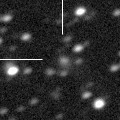
|
Now it is 17.0 mag (Mar. 13, E. Primucci). In the Southern Hemisphere, it is observable at 17 mag in good condition in spring. It stays extremely low in the Northern Hemisphere.
Date(TT) R.A. (2000) Decl. Delta r Elong. m1 Best Time(A, h)
Apr. 22 12 47.92 -42 11.7 5.061 5.922 146 17.2 22:45 ( 0, 13)
Apr. 29 12 44.97 -41 0.2 5.062 5.920 145 17.2 22:14 ( 0, 14)
|
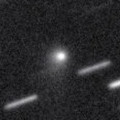
|
It brightened up to 15 mag in early 2016. Now it is fading. It has already faded down to 17.1 mag (Mar. 3, K. Hills). In the Northern Hemisphere, it stays observable in good condition for a long time until autumn when the comet will be fainter than 18 mag. It will never be observable after this in the Southern Hemisphere.
Date(TT) R.A. (2000) Decl. Delta r Elong. m1 Best Time(A, h)
Apr. 22 14 27.53 71 50.9 6.464 6.643 95 17.3 0:28 (180, 53)
Apr. 29 14 16.75 71 24.7 6.524 6.674 94 17.3 23:45 (180, 54)
|

|
It has not been observed since last April. Now it is fading. But it must be bright as 17 mag still now.
Date(TT) R.A. (2000) Decl. Delta r Elong. m1 Best Time(A, h)
Apr. 22 17 4.34 -17 33.0 2.582 3.367 134 17.3 3:05 ( 0, 37)
Apr. 29 17 0.30 -17 5.9 2.583 3.438 142 17.4 2:33 ( 0, 38)
|
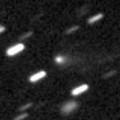
|
Now it is 17.0 mag (Mar. 2, Kunihiro Shima). It is observable in excellent condition in the Northern Hemisphere. It locates low in the Southern Hemisphere.
Date(TT) R.A. (2000) Decl. Delta r Elong. m1 Best Time(A, h)
Apr. 22 7 19.20 29 54.0 3.705 3.589 75 17.4 20:08 ( 94, 54)
Apr. 29 7 26.74 29 23.8 3.814 3.605 70 17.5 20:16 ( 97, 48)
|
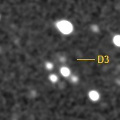
|
Now it is 17.1 mag (Mar. 7, iTelescope Observatory, Siding Spring). It is observable at 17.5 mag in good condition in spring. It locates somewhat low in the Northern Hemisphere.
Date(TT) R.A. (2000) Decl. Delta r Elong. m1 Best Time(A, h)
Apr. 22 12 22.22 -24 3.5 4.047 4.971 154 17.5 22:19 ( 0, 31)
Apr. 29 12 15.45 -22 9.7 4.086 4.971 148 17.5 21:45 ( 0, 33)
|
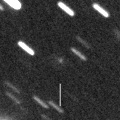
|
It stays at 14 mag for a long time from 2018 to 2019. In the Northern Hemisphere, it stays observable in good condition while the comet will be brightening gradually. In the Southern Hemisphere, it is not observable until 2018 October.
Date(TT) R.A. (2000) Decl. Delta r Elong. m1 Best Time(A, h)
Apr. 22 18 23.41 51 14.3 4.961 5.144 94 17.6 3:49 (198, 73)
Apr. 29 18 17.65 53 1.3 4.882 5.092 96 17.5 3:38 (186, 72)
|
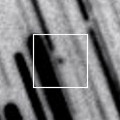
|
It will be observable at 17.5 mag in good condition from April to May.
Date(TT) R.A. (2000) Decl. Delta r Elong. m1 Best Time(A, h)
Apr. 22 17 33.06 -9 31.7 1.718 2.461 127 17.6 3:34 ( 0, 46)
Apr. 29 17 10.46 -11 6.6 1.636 2.490 139 17.5 2:44 ( 0, 44)
|
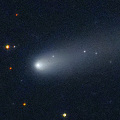
|
It brightened up to 11-12 mag from summer to autumn in last year. Now it is fading. It has already faded down to 16.0 mag (Mar. 30, Kunihiro Shima).
Date(TT) R.A. (2000) Decl. Delta r Elong. m1 Best Time(A, h)
Apr. 22 11 33.23 -19 9.5 1.847 2.728 144 17.6 21:30 ( 0, 36)
Apr. 29 11 31.65 -17 55.4 1.939 2.773 138 17.9 21:01 ( 0, 37)
|
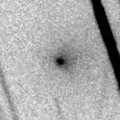
|
Small comet, but it approached to Sun down to 0.9 a.u., and to Earth down to 0.5 a.u. It brightened very rapidly, and brightened up to 10.7 mag in late February (Feb. 24, Juan Jose Gonzalez). It is fading very rapidly after that. It has already faded down to 18.7 mag (Mar. 29, Kunihiro Shima). It is observable in excellent condition in the Northern Hemisphere. In the Southern Hemisphere, it is not observable after this.
Date(TT) R.A. (2000) Decl. Delta r Elong. m1 Best Time(A, h)
Apr. 22 11 42.63 68 37.3 0.581 1.210 95 17.7 21:45 (180, 57)
Apr. 29 12 27.92 60 13.7 0.626 1.289 101 18.1 22:00 (180, 66)
|
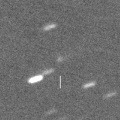
|
Now it is 17.9 mag (Mar. 30, Kunihiro Shima). It will be fainter than 18 mag in May.
Date(TT) R.A. (2000) Decl. Delta r Elong. m1 Best Time(A, h)
Apr. 22 14 55.90 -11 14.9 1.540 2.527 165 17.9 0:57 ( 0, 44)
Apr. 29 14 50.23 -11 6.1 1.545 2.548 173 17.8 0:24 ( 0, 44)
|
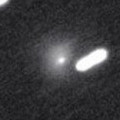
|
Very far object. Outburst occured on Feb. 20, 2015, and it brightened up to 15 mag. Now it is 18.3 mag (Mar. 30, Kunihiro Shima). It is observable in excellent condition in the Southern Hemisphere. It locates low in the Northern Hemisphere.
Date(TT) R.A. (2000) Decl. Delta r Elong. m1 Best Time(A, h)
Apr. 22 14 34.40 -25 56.0 8.429 9.398 163 17.9 0:35 ( 0, 29)
Apr. 29 14 32.39 -25 41.8 8.415 9.404 168 17.9 0:06 ( 0, 29)
|
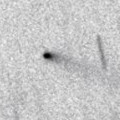
|
Now it is 18.0 mag (Mar. 28, Kunihiro Shima). It was observed at 17 mag in early 2016 and early 2017. It will be fainter than 18 mag in May. It is observable in good condition in the Northern Hemisphere. But it locates low in the Southern Hemisphere.
Date(TT) R.A. (2000) Decl. Delta r Elong. m1 Best Time(A, h)
Apr. 22 10 54.13 42 53.8 3.910 4.368 110 17.9 20:52 (180, 82)
Apr. 29 10 54.15 42 56.5 4.030 4.401 105 18.0 20:24 (180, 82)
|
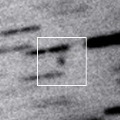
|
It stays observable at 18 mag from spring to summer. It is observable in excellent condition in the Southern Hemisphere. In the Northern Hemisphere, it stays unobservable for some more time.
Date(TT) R.A. (2000) Decl. Delta r Elong. m1 Best Time(A, h)
Apr. 22 22 11.44 -35 0.3 5.482 5.249 71 17.9 3:49 (312, -3)
Apr. 29 22 16.12 -34 41.6 5.406 5.267 76 17.9 3:38 (313, -1)
|
|
![]()
 C/2017 E4 ( Lovejoy )
C/2017 E4 ( Lovejoy ) 71P/Clark
71P/Clark 2P/Encke
2P/Encke 73P/Schwassmann-Wachmann 3
73P/Schwassmann-Wachmann 3 29P/Schwassmann-Wachmann 1
29P/Schwassmann-Wachmann 1 65P/Gunn
65P/Gunn C/2016 R2 ( PanSTARRS )
C/2016 R2 ( PanSTARRS ) 213P/Van Ness
213P/Van Ness C/2015 O1 ( PanSTARRS )
C/2015 O1 ( PanSTARRS ) C/2015 VL62 ( Lemmon-Yeung-PanSTARRS )
C/2015 VL62 ( Lemmon-Yeung-PanSTARRS ) 217P/LINEAR
217P/LINEAR C/2016 N4 ( MASTER )
C/2016 N4 ( MASTER ) 315P/2013 V6 ( LONEOS )
315P/2013 V6 ( LONEOS ) C/2011 KP36 ( Spacewatch )
C/2011 KP36 ( Spacewatch ) C/2016 M1 ( PanSTARRS )
C/2016 M1 ( PanSTARRS ) C/2014 B1 ( Schwartz )
C/2014 B1 ( Schwartz ) 81P/Wild 2
81P/Wild 2 C/2016 B1 ( NEOWISE )
C/2016 B1 ( NEOWISE ) 74P/Smirnova-Chernykh
74P/Smirnova-Chernykh 45P/Honda-Mrkos-Pajdusakova
45P/Honda-Mrkos-Pajdusakova C/2013 X1 ( PanSTARRS )
C/2013 X1 ( PanSTARRS ) C/2014 OE4 ( PanSTARRS )
C/2014 OE4 ( PanSTARRS ) C/2017 D2 ( Barros )
C/2017 D2 ( Barros ) C/2014 W2 ( PanSTARRS )
C/2014 W2 ( PanSTARRS ) C/2016 A1 ( PanSTARRS )
C/2016 A1 ( PanSTARRS ) P/2000 S1 ( Skiff )
P/2000 S1 ( Skiff ) 157P/Tritton
157P/Tritton C/2014 R3 ( PanSTARRS )
C/2014 R3 ( PanSTARRS ) C/2017 E3 ( PanSTARRS )
C/2017 E3 ( PanSTARRS ) C/2013 V4 ( Catalina )
C/2013 V4 ( Catalina ) C/2015 TQ209 ( LINEAR )
C/2015 TQ209 ( LINEAR ) P/2015 TP200 ( LINEAR )
P/2015 TP200 ( LINEAR ) C/2017 D3 ( ATLAS )
C/2017 D3 ( ATLAS ) C/2016 N6 ( PanSTARRS )
C/2016 N6 ( PanSTARRS ) C/2016 T1 ( Matheny )
C/2016 T1 ( Matheny ) 43P/Wolf-Harrington
43P/Wolf-Harrington C/2016 VZ18 ( PanSTARRS )
C/2016 VZ18 ( PanSTARRS ) 94P/Russell 4
94P/Russell 4 C/2013 C2 ( Tenagra )
C/2013 C2 ( Tenagra ) C/2015 X7 ( ATLAS )
C/2015 X7 ( ATLAS ) C/2015 H2 ( PanSTARRS )
C/2015 H2 ( PanSTARRS )![]()









































